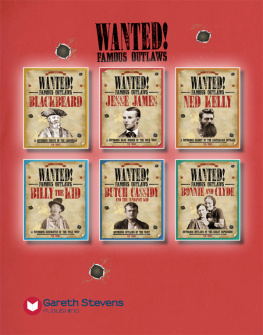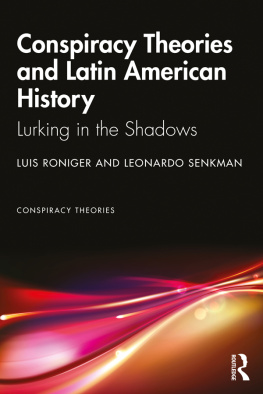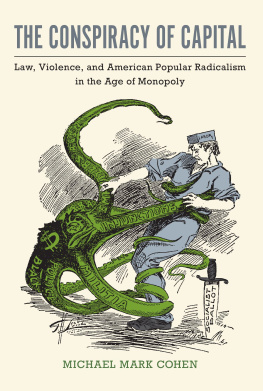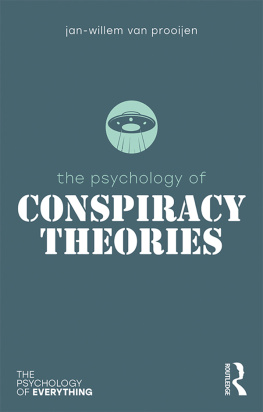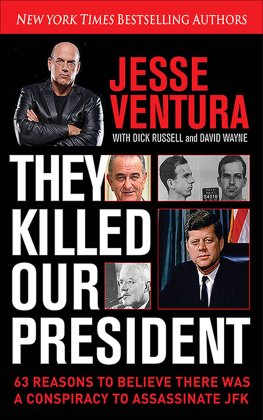For Maya and Lila,
live fearlessly
Cant you see, hed said, the truth is so much more interesting: secret societies have not had power in history, but the notion that secret societies have had power in history has had power in history.
John Crowley, gypt
CONTENTS

If men define situations as real, they are real in their consequences.
William and Dorothy Thomas
O n January 30, 1835, as Andrew Jackson exited a congressmans funeral, an assassin drew a weapon and pointed it at the president. The pistol misfired. The gunman pulled a second weapon from his cloak. Though loaded, it too failed to fire. The cane-wielding Jackson and several bystanders subdued the would-be killer, an unemployed housepainter named Richard Lawrence. Lawrence later informed interrogators that he was King Richard III, that Jackson had killed his father, and that with Jackson dead money would be more plenty. He was judged insane and committed to an asylum, where he died three decades later. Lawrence was a lone nut.
Or at least that was the official story. It wasnt long before two witnesses filed affidavits claiming to have seen Lawrence at the home of the Mississippi senator George Poindexter shortly before the attack. Poindexter was a noisy opponent of the Jackson administration, and pro-Jackson newspapers accused the senator of plotting the presidents murder. So did Jacksons allies in Congress, who quickly convened an investigation. Jackson himself told bystanders after the assault that the shooter had been hired by that damned rascal Poindexter to assassinate me.
Some of Jacksons critics countered by suggesting that the president had staged the assault to gain public support, and that this explained why both weapons had failed. And many Jacksonians pointed their finger at John Calhoun, the South Carolina senator and former vice president, arguing that if he had not been directly involved in the assassination attempt, he had at the very least incited it with a speech denouncing Jackson as an American Caesar.
When the Republican writer John Smith Dye described the crime twenty-nine years later, he saw an even more devilish plot at work. Calhoun might not have been directly involved in the assault, Dye conceded: Whether this man was induced to attempt to murder the President by listening to his defamer making speeches in the Senate ... or whether he was secretly hired to assassinate him, God alone can determine. But Dye believed that Calhoun had been a part of a larger force, the Slave Power, that would have benefited if Jackson had been put in the ground. And the Slave Power, Dye informed his readers, was more than willing to kill a powerful man to get its way.
In 1841, for example, President William Henry Harrison told Calhoun he wasnt sure he was willing to annex Texas, which southerners wanted to add to the union as a slave state. Harrison promptly died. Officially the cause of death was pneumonia, but Dye was sure that arsenic was to blame. Nine years later, Dye continued, President Zachary Taylor opposed the Slave Powers agenda in Cuba and the Southwest, and so he was killed by the same poison. And when President-elect James Buchanan prepared to make some appointments of which the slaveocrats disapproved, Dye declared, he narrowly survived one of the most elaborate assassination plots ever conceived.
On February 23, 1857, according to Dye, southern agents poisoned all the bowls containing lump sugar at the National Hotel in Washington, D.C. Southerners, he explained, drink coffee; coffee drinkers use pulverized sugar; so the southern diners would be spared and the tea-drinking northern diners, including Buchanan, would be wiped out. The future president barely survived the illness that followed. Intimidated by the attempted assassination, Dye wrote, Buchanan became more than ever the tool of the slave power.
There is little evidence for Dyes explosive charges. You can make a case that Harrisons doctors did more to hurt than to help the ailing president, but no more than conjecture supports the idea that anyone deliberately killed him. Coroners debunked the belief that Zachary Taylor had been poisoned when his body was exhumed in 1991. And Buchanan was not even present in Washington on February 23, 1857, though dysentery did break out at the hotel when Buchanan stayed there a month earlier and again when he returned for his inauguration. Today the outbreaks are usually attributed to a sewage backup that contaminated the inns food and water, but at the time several stories circulated blaming poisoners for the illnesses, with the suspects ranging from a Chinese cabal to a band of homicidal abolitionists. Inconveniently for Dyes tea-and-coffee thesis, the dead included a southern congressman, John Quitman of Mississippi.
But when Dyes book The Adders Den was published in 1864, the country was at war with the South, and when a new edition appeared two years later, under the title History of the Plots and Crimes of the Great Conspiracy to Overthrow Liberty in America , the nation was still reeling from the assassination of Abraham Lincoln.

Richard Lawrence attempts to kill Andrew Jackson, National Archives
Nor did Dye invent his theories from nothing: He drew on rumors that had been floating through Whig and Republican circles for years. After Lincoln was electedwell before Dyes book appearedseveral supporters of the incoming president sent letters warning him to watch out for the plotters who had killed two of his predecessors. General Harrison livd but a Short time after he was Installd in office, one concerned citizen pointed out, and General Taylor livd but a short time after he took his seat.... You Sir be careful at the Kings table what meat and drink you take.
After Lincoln died, at least two prominent ministersGeorge Duffield of Detroit and William Goodwin of Connecticutworked the supposed murders of Harrison and Taylor into their sermons. Reverend Henry Ward Beecher not only invoked their alleged assassinations in an article for The New York Ledger but added the antisecessionist Democrat Stephen Douglas to the list of victims, writing that he had been killed because his position in the party made him one of the most efficient champions against the Rebellion.
And in May 1868, an extraordinary article in the New-York Tribune managed to out-Dye Dye, accusing a Democratic conspiracy of engineering the citys malaria outbreaks. After commenting that Zachary Taylor fell under the malarious vapors of Washington and died because he was prone to acting honestly and straightforward, the Tribune writer claimed that Washington in subsequent years was free of malariathat is, for Democrats; but when the new Republican party began to gain strength, and it was possible that they might become the ruling power in Congress, the water of Washington suddenly grew dangerous, the hotels (particularly the National) became pest-houses, and dozens of heretics from the Democratic faith grew sick almost unto death. The contagions continued until Lincoln put the walls and springs of the Capital under the care of loyal soldiers, ending the outbreaks. But after Lincoln was deposed, the pattern returned: Right before the vote to impeach Johnson, we had a return of that bad water, and two or three SenatorsRepublicans, mind youare prostrated with sudden illness. What does it mean? Why does it happen that whenever the current sets against the Master Demon of Slavery ( and never at any other time ), we find the air, and the water, and the whisky of Washington full of poison?



